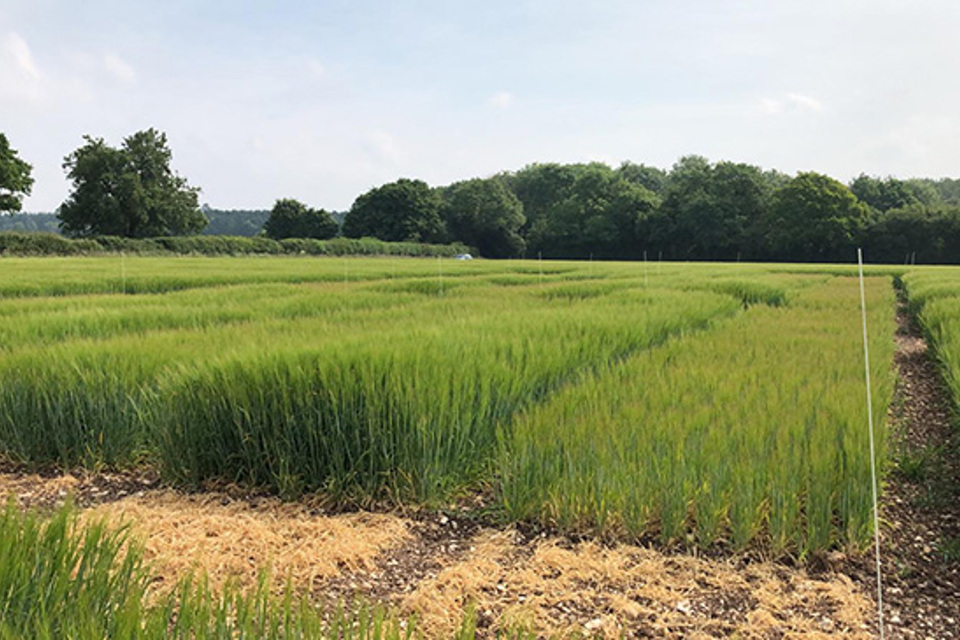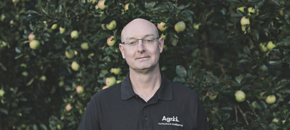
Dorset iFarm Recipe defies the season to deliver Best-Ever Spring Barley
News - 19.01.21
Despite the most challenging conditions they’ve ever known for the crop, Eastbury Estates averaged a record 9.3t/ha from the 100ha of spring barley they grew.
Despite the most challenging conditions they’ve ever known for the crop, Eastbury Estates averaged a record 9.3t/ha from the 100ha of spring barley they grew at Tarrant Gunville near Blandford in Dorset last season, maintaining the substantial productivity progress the Agrii iFarm has made over the past three years.
With their normal annual average of around 800mm of rain falling between September and March, Jim Farquharson and his agronomist, Todd Jex couldn’t drill their 2020 crop until the last week of the month – a good two weeks later than their target. After which hyper-local Rhiza weather records show it received just 63mm to the beginning of June, piling on the pressure.
“Long in the bed, long in the head has always been our guiding principle with spring barley,” says Mr Farquharson who runs the family’s 400 ha downland arable business at the southern end of Cranborne Chase.
“We’ve moved our five-year average up from around 6t/ha to 7.5t/ha in recent years. But with such a late start we revised our 2020 budget down to little more than 7t/ha at sowing. Then down again with the dry spring to nearer 6.5 tonnes
“Under these conditions breaking the 9t/ha average for the first time on our yield-limited ground and seeing our best field do 10.5t was fantastic.”
Gratifying though it was, the performance came as little surprise to the Dorset iFarm team at harvest, given both the precision agronomy progress they’ve been making since having the whole farm soil conductivity scanned in 2018 and the close correlation they find between their Rhiza NDVI satellite imagery in May and combine yield maps.
Part of the 2020 yield uplift almost certainly resulted from the decision to grow their Laureate for feed rather than malting – following maltsters reluctance to take the variety in 2019 and with premium prospects damped by the massive area of UK spring barley planted.
“We calculated that three-quarters of a tonne extra in the barn would deliver us a better margin than a £5t/tonne premium,” Mr Farquharson explains. “So, we used a little more nitrogen than we normally do for malting. At around 185kg/ha, this was only an extra 30kg or so, though.
“It did mean our grain nitrogens were over the malting spec at 1.85%. However, exceeding our original yield budget by more than a tonne and a half left us well-pleased. More than anything else, it really underlined the value of the extra emphasis we’ve been putting on early management, in general, and nutrition, in particular.”
Eastbury Estates have long appreciated that as a sink (and time) limited crop with a restricted tillering ability, the first few weeks of life are the most crucial determinants of spring barley performance. To get the minimum 600 ears/m2 they want at harvest, they have always prioritised clean, rapid establishment and early nutrition, drilling at least 350 seeds/m2 into well-prepared seedbeds and applying all the nitrogen before GS13.
Even so, they have employed the latest Agrii research to make a number of significant improvements in these and other key areas of their agronomy to increase both the level and consistency of crop performance.
Most importantly:
- Slow-release sulphur (together with variable rate potash, where needed) in the spring, just ahead of drilling;
- A specialist starter fertiliser with protected phosphate and nitrogen placed around 1” below the seed at drilling;
- Variable-rate nitrogen, where necessary, to even-up the canopy once the crop rows are visible; and,
- Highly bio-available trace elements with the spray programme, informed by the most accurate, crop growth curve-based tissue analysis guidelines.
“We now apply a flat rate of 100kg/ha of polysulphate ahead of drilling, giving us 48kg/ha of SO3,” points out Mr Jex. “This is mainly because we were struggling to get enough nitrogen on with the sulphur we needed with an N:S compound. The polysulphate also has the advantage of supplying 14kg/ha of potash and 6kg/ha of magnesium, all in a suitably slow-release form.
“The seedbed N we apply now goes on with phosphate at drilling in a specialist starter fertiliser. The 32.6N:22 P AgriiStart formulation provides our nitrogen as protected urea for optimum uptake with minimum leaching risk. It’s P-Reserve coating also protects the phosphate from lock-up on our high pH soils. Last season we put on 300 kg/ha to deliver
98 kg/ha of nitrogen and 66 kg/ha of phosphate. Then we gave the crop a further 92 kg/ha of nitrate N at 2-3 leaves.”
A newly-acquired Horsch Sprinter with twin tanks means the starter fertiliser can be placed just below the seed into ground set-up with a single pass from a Vaderstad Swift or Discordon, depending on conditions.
“We haven’t ploughed for 25 years,” Mr Farquharson says. “We give our stubbles a light straw rake after harvest to bring on the volunteers and grassweeds, then spray it off with glyphosate ahead of min-tilling in the spring. Drilling with the least disturbance and good closure and consolidation with an extra set of press wheels on the Sprinter really helps us preserve the moisture as well as deal with the flints that are a constant headache here.
“Drilling evenly into a decent seedbed, getting the starter fertiliser immediately below the seed where it will do most good, and avoiding as much moisture loss as possible were especially important for us last spring.”
“Variable rate P&K on top of regular additions of biosolids over the years have evened-up soil indices well across the arable area,” reveals Rhiza specialist, Chris Hoskins. “This and the perennial problem of phosphate lock-up in soils with a pH of 8.0 means we can now apply all the P at a flat rate in fresh available form to feed the plant rather than the soil, only varying our potash applications where we still need to.
“We have been using variable N based on our soil mapping and early crop variations to even-up the spring barley growth. But the lateness of our 2020 drilling meant we applied all last year’s second dose at a flat rate. This will probably be our standard practice in the future as the new drill enables us to employ variable rate seeding for the first time.
“Using our soil management zones and Jim and Todd’s knowledge of the fields – especially key areas of blackgrass, slug and game-bird pressures – we plan to vary sowing rates from 350 to 450 seeds/m2 to substantially improve crop evenness from the start. By doing so, and using satellite NDVI images increasingly actively to identify issues in the crop before they’re visible to the eye, we’re setting our sights on 9.5t/ha as realistic target from 2021.”
Regular Rhiza imagery is already proving valuable in the early identification of ‘hot spots’ of less good crop growth for most effective targeting of the Estates’ 3-4 post-em spray crop protection regime – an early graminicide to deal with wild oats, in particular; T1 and T2 fungicides; and, an intermediate flag leaf PGR, if necessary.
At the same time, it is playing a key role in increasing the precision of the season-long micro-nutrition that has been as important as the early nutritional improvements in lifting spring barley performance.
“We tissue test ahead of all our sprays to identify any limiting micro-nutrients throughout the season,” Mr Jex stresses. “The growth curve-based benchmarking regime Agrii researchers have developed with Lancrop is a huge advantage in interpreting the analyses. At the same time, I find the eye-in-the-sky images really useful in making sure our sampling for tissue testing accurately reflect the state of the crop – poorer as well as better areas of growth.
“This ensures our micro-nutrient prescriptions are spot on. We invariably find extra manganese is needed early here and include the zinc known to be so valuable in root development. At T1 in early May copper is often called-for as well as extra manganese, while at T2 (awn emergence) it tends to be copper and magnesium – which is important in helping drought tolerance.
“Tip-top micro-nutrition through the season really helps us make the most of our nitrogen, in particular, optimising early tiller production and tiller retention; especially with a spring as dry as 2020.
“Interestingly too, Chris drew our attention to a ‘mystery square’ in one of last season’s Rhiza spring barley images,” adds Mr Jex. “On investigation, it proved to be a small area that didn’t get starter fertiliser following a GPS error. We were able to track this right through to the yield map at harvest – underlining just how valuable well-placed starter fertilisation is in our recipe.”
Join Our Community

Agrii X
We love engaging with clients and partners. Give us a follow and let's share stories for the community.

Agrii Instagram
A picture paints a thousand words. Follow us on Instagram to see what we are up to.

Agrii Facebook
Follow us on the worlds biggest social media site for the latest news and events straight to your feed.

Agrii LinkedIn
If you are all about the business, connect with us on LinkedIn to build your network
Stay In Touch

Newsletter Sign-Up
Receive email updates on topical news and information from around Agrii and UK Farming.

Listen To Our Podcasts
Listen to the Tramlines Podcast. Fortnightly chat about agriculture and trials with your host Tony Smith.

Agrii Insights
Read essential agri intelligence for profitable farming.

Find an Event
Join us for our upcoming events and tours.



